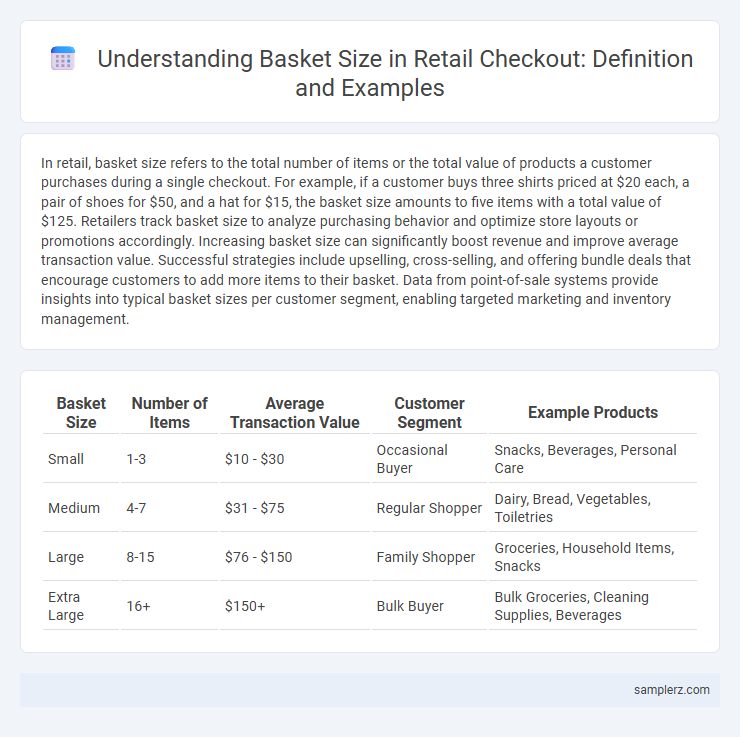In retail, basket size refers to the total number of items or the total value of products a customer purchases during a single checkout. For example, if a customer buys three shirts priced at $20 each, a pair of shoes for $50, and a hat for $15, the basket size amounts to five items with a total value of $125. Retailers track basket size to analyze purchasing behavior and optimize store layouts or promotions accordingly. Increasing basket size can significantly boost revenue and improve average transaction value. Successful strategies include upselling, cross-selling, and offering bundle deals that encourage customers to add more items to their basket. Data from point-of-sale systems provide insights into typical basket sizes per customer segment, enabling targeted marketing and inventory management.
Table of Comparison
| Basket Size | Number of Items | Average Transaction Value | Customer Segment | Example Products |
|---|---|---|---|---|
| Small | 1-3 | $10 - $30 | Occasional Buyer | Snacks, Beverages, Personal Care |
| Medium | 4-7 | $31 - $75 | Regular Shopper | Dairy, Bread, Vegetables, Toiletries |
| Large | 8-15 | $76 - $150 | Family Shopper | Groceries, Household Items, Snacks |
| Extra Large | 16+ | $150+ | Bulk Buyer | Bulk Groceries, Cleaning Supplies, Beverages |
Understanding Basket Size in Retail Checkout
Basket size in retail checkout refers to the total number of items a customer purchases in a single transaction, directly impacting store revenue and inventory management. Analyzing basket size helps retailers tailor promotions, optimize product placement, and enhance upselling strategies to increase average transaction value. Data-driven insights into customer purchasing behavior at checkout enable personalized offers that boost customer satisfaction and loyalty.
Factors Influencing Basket Size at Checkout
Basket size at checkout is influenced by factors such as product diversity, promotional offers, and shopper behavior. Store layout and online interface design play critical roles in encouraging consumers to add more items, while price sensitivity and loyalty programs enhance purchasing frequency and volume. Understanding customer demographics and seasonal trends also helps retailers optimize basket size through targeted marketing and personalized recommendations.
Examples of Typical Basket Sizes in Grocery Stores
Typical basket sizes in grocery stores range from small baskets holding around 5 to 10 items for quick trips, to medium-sized baskets containing 20 to 30 products for weekly shopping. Larger basket sizes often include 40 to 60 items, reflecting bulk purchases or family needs. Average basket values typically range between $30 and $80, depending on store location and customer purchasing behavior.
Basket Size Metrics for Online vs. In-Store Shopping
Basket size metrics demonstrate a significant variance between online and in-store shopping behaviors, with average online basket sizes typically larger due to the convenience of browsing and access to wider product assortments. Data shows that online shoppers often include 10-20% more items per transaction compared to in-store purchases, influenced by digital recommendations and easier comparison shopping. In contrast, in-store basket sizes are constrained by physical factors but benefit from impulse buys, often reflected in higher average transaction values despite fewer items.
Analyzing Basket Size Trends in Self-Checkout Lanes
Analyzing basket size trends in self-checkout lanes reveals that customers typically purchase an average of 5 to 7 items per transaction, with larger baskets often consisting of 10 or more products during peak shopping hours. Data from multiple retail chains indicate a 15% increase in basket size compared to traditional checkout lanes, attributed to faster processing and perceived convenience. Understanding these trends helps retailers optimize product placement and inventory management to enhance customer experience and sales performance.
Impact of Promotions on Basket Size During Checkout
Promotions significantly influence basket size during checkout by encouraging customers to add more items, boosting average order value by up to 30%. Limited-time discounts and bundle deals effectively increase the quantity and diversity of products purchased per transaction. Retailers utilizing targeted promotions report higher customer engagement and increased sales, highlighting the critical role of strategic offers in expanding basket size.
Case Study: Increasing Basket Size with Cross-Selling
A leading retail chain implemented strategic cross-selling techniques at checkout, presenting complementary products such as batteries with electronics and skincare items with cosmetics, resulting in a 15% increase in average basket size over six months. Using targeted prompts and data-driven product pairings, the initiative boosted customer spend per transaction while enhancing shopping convenience. This case study highlights how personalized recommendations at checkout effectively elevate basket value and drive revenue growth.
Basket Size Examples by Retail Category
Basket size varies significantly across retail categories, with grocery stores typically averaging $30 to $50 per transaction, while electronics retailers see higher basket sizes ranging from $150 to $300 due to higher-priced items. Apparel stores often experience basket sizes around $70 to $120, influenced by seasonal promotions and fashion trends. Health and beauty retailers usually report basket sizes between $40 and $80, driven by frequent purchases of consumables and personal care products.
Measuring Basket Size to Improve Customer Experience
Measuring basket size during checkout reveals the average number of items per transaction, providing insights into customer purchasing behavior. Retailers analyze basket size data to optimize product placement and personalize promotions, enhancing shopping convenience and satisfaction. Increasing the average basket size directly contributes to higher sales and a more engaging customer experience.
Strategies Retailers Use to Boost Basket Size at Checkout
Retailers boost basket size at checkout by implementing upselling techniques, such as recommending complementary products based on the shopper's cart contents. Loyalty programs offering exclusive discounts encourage customers to add more items to maximize savings. Strategic placement of impulse-buy items near the checkout counter also drives incremental purchases, increasing the average transaction value.

example of basket size in checkout Infographic
 samplerz.com
samplerz.com